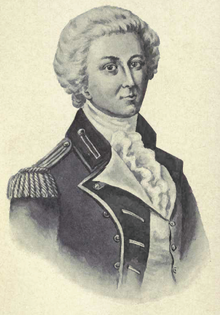Samuel Smith (Upper Canada politician)
| Samuel Smith | |
|---|---|
 |
|
| Administrator of the Government of Upper Canada | |
|
In office 11 June 1817 – 13 August 1818 |
|
| Monarch | George III |
| Preceded by | Sir Frederick Philipse Robinson GCB (acting Governor) |
| Succeeded by | Sir Peregrine Maitland KCB GCB |
|
In office 8 March 1820 – 30 June 1820 |
|
| Monarch | George IV |
| Preceded by | Sir Peregrine Maitland KCB GCB |
| Succeeded by | Sir Peregrine Maitland KCB GCB |
| Personal details | |
| Born |
27 December 1756 Hempstead, New York |
| Died |
20 October 1826 (aged 69) York, Upper Canada |
| Spouse(s) | Jane Isabella Clarke |
| Religion | Anglican |
| Military service | |
| Allegiance |
|
| Service/branch |
|
| Years of service | 1777–1802 |
| Rank | Captain, Lieutenant Colonel |
| Battles/wars | Battle of Yorktown |
Samuel Bois Smith (27 December 1756 – 20 October 1826) was a Loyalist British Army officer and politician. He was appointed to the Executive Council of Upper Canada and appointed Administrator of Upper Canada.
Smith was born in Hempstead, New York, the son of Scottish immigrants. In 1777, he joined the Queen's Rangers during the American Revolutionary War. He surrendered to the Americans after the Battle of Yorktown. Smith moved to the newly created colony of New Brunswick and then to England. He rose to the rank of captain and was sent to Niagara. He was promoted to the position of lieutenant-colonel of his regiment in 1801 before retiring to 1,000 acres (4 km²) of land he had bought in Etobicoke. Later some of this land was sold to John Strachan for the original Trinity College campus, now Trinity Bellwoods Park. Smith was appointed 30 November 1813 to the Executive Council of Upper Canada for the town of Etobicoke.
In 1817 he was sworn in as Administrator of Upper Canada in the absence of Lieutenant Governor Francis Gore and served until 1818. He acted again as Administrator in the absence of Lieutenant Governor Sir Peregrine Maitland for three months in 1820.
...
Wikipedia
